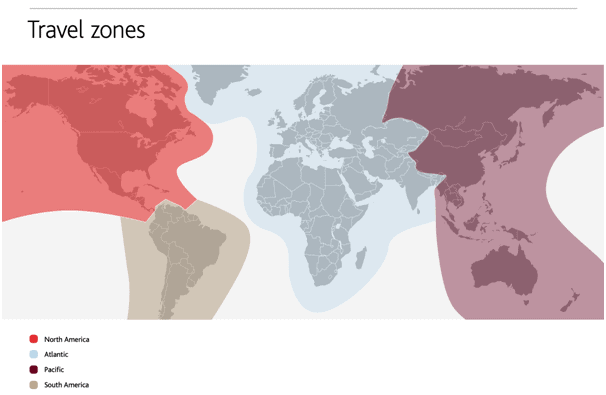The Complete Guide to the New Aeroplan

This fall, Air Canada will unveil a new and improved Aeroplan loyalty program. Canada’s largest airline has been promising big changes for a while now, and with the COVID-19 pandemic posing a serious threat to the entire travel industry in 2020, an upgraded loyalty program couldn’t come at a better time.
According to Air Canada, the goal of the transformed Aeroplan is to “get you to a flight reward, more easily, with more value.” We’ll find out if that’s indeed the case, but for now the proposed changes sound promising. In this article I’ll let you know what you can expect from the new Aeroplan program so that you’re prepared for it’s launch in a couple of months.
New Aeroplan Rewards Launch Date
The new Aeroplan program comes into effect on November 8, 2020, with a new Aeroplan logo which will be more closely linked to the Air Canada brand. As of this date, current members will see their existing miles converted 1:1 to Aeroplan points, and the new features will take effect.
Key Changes In the New Aeroplan Program
Given that this is a complete revamp of the Aeroplan program, it’s probably best to begin by highlighting the many changes you’ll see after November 8th. From there, I’ll get into the details so that you know what to expect.
The New Aeroplan – What to Expect
- Launch date November 8, 2020
- Aeroplan miles switching to points
- Elimination of additional fuel and carrier surcharges
- Removal of blackout periods
- Family sharing feature allows for pooling of points
- All seats are now available on Air Canada flights
- New hybrid flight reward charts combines zones and distance
- Outside of Canada and US, a stopover on a one way flight will be permitted
- Aeroplan credit card partners are launching new products (TD Bank, CIBC, AMEX)
- New Aeroplan Elite status to replace Air Canada Altitude
- New Aeroplan logo will be more closely integrated with Air Canada
Aeroplan Miles Are Switching to Points
One of the biggest changes coming to Aeroplan is that Aeroplan miles will now be referred to as points. Existing Aeroplan members need not worry, however, as their miles will be converted to an equivalent value of points when the new program goes live.
More Transparent Pricing
Pricing is becoming a lot more transparent under the new Aeroplan. Instead of a points system that’s based on how far you travel (miles), it will be more closely related to the price of the ticket you are buying. Thankfully, Air Canada has added a new Points Predictor Tool on their website, which makes it easy to see how many points you’ll need to cover your flight.
Using the tool, simply input your starting and ending points, and you’ll be provided with an estimate for each seat class ie. Economy, Premium Economy, Business. To illustrate, I plugged in a one-way flight between Calgary and Toronto, which you can see below:

With the new system, Air Canada is doing away with the two-tiered Fixed Mileage Flight Rewards and Market Fare Flight Rewards. Instead, you can use your points to purchase any available Air Canada seat, regardless of cabin class. They are also eliminating blackout periods, so you can use your points for travel at any time.
Aeroplan point redemption values will be based on a dynamic model (more on that later), however, rewards booked on partner airlines have been assigned a fixed amount of points, for added clarity.
Removal of Airline Surcharges
Another welcome change under the new Aeroplan is the removal of additional airline surcharges. The only additional fees you will encounter are taxes, and fees from 3rd parties, ie. airport fees). The best part is that you’ll be able to use your points to cover these charges. Partner airlines will charge a flat fee of $39 per ticket, but you’ll be able to redeem your points to cover that as well.
Additional Stopovers are Now Included
In the current program, only one stopover is allowed. Under the new program, members can plan their round-the-world trip with unlimited stopovers at an additional cost of 5000 points each. You can also add up to 15 layovers of less than 24 hours. While this could end up being very costly, it does open up the possibilities. I should point out that this is for international flights only, North American domestic flights are not included.
Aeroplan Family Sharing
Under the new Aeroplan, you will be able to create groups and pool your points with up to 8 other people. This makes it possible to redeem points faster. While the feature is called Aeroplan Family Sharing, the people you pool points with do not have to be family members. It can also include friends or colleagues. Points are redeemed according to the percentage of points each group member has.
For example, let’s say you have a group that includes you and 2 friends. You own 50% of the points in the group, and each of your friends have 25%. If one of you wants to book a trip that requires 10,000 points, you would contribute 5,000, and each of your friends would contribute 2,500. Aeroplan requires that you remain in a group for a minimum of 3 months, and you cannot belong to multiple groups at the same time.
Understanding the New Aeroplan Flight Rewards Chart
Experienced Aeroplan members know that to get the most out of the program, a thorough understanding of the Aeroplan Flight Rewards Chart is key. With the launch of the new program, everyone has some learning to do, given that Aeroplan completely reworked the chart. Here’s what you need to know.
The New Flight Rewards Chart has 4 Zones
Aeroplan is dividing the world into 4 travel zones with their new chart: North America (including Hawaii), South America, Atlantic, and Pacific. The Atlantic zone includes all of Europe and Africa, and parts of Asia, including India. The Pacific zone includes the remainder of Asia, and Australia.

Each world zone is divided up by distance zones. In the image below, you can see that North America has 4 separate distance thresholds, with each one requiring an increasing number of points. Air Canada flights use a dynamic pricing model, while the partner flights are fixed.
For example, flights between 501-1,500 miles would range between 10,000-15,000 points on Air Canada, while a partner flight over the same distance is fixed at 10,000 points. I’ll get into the dynamic pricing a bit later, but the number of points required will depend on the popularity of a given route, as well as the time of year you are travelling.

You’ll notice that there are even more charts that account for travel between any combination of world zones. It all adds up to a lot of charts, but each one is well laid out and easy to understand.

How Will I Redeem My Aeroplan Points?
Under the new Aeroplan, redeeming your points will be easier than ever before. For starters, members will no longer need to login to a separate website in order to redeem rewards. Instead, you can access your Aeroplan account at AirCanada.com, or on the Air Canada mobile app.
Once there, you have the option of redeeming your points for just about any aspect of your trip. In addition to flights, Aeroplan points can pay for hotels, car rentals, and vacation packages. You can even spend your points on other rewards, such as gift cards, electronics, or activities and entertainment.
Flexible Booking with Points and Cash
According to Air Canada, the new Aeroplan will allow you to combine your points with cash to book flights, if you don’t have enough points to cover the entire trip. This is a nice feature that adds to the flexibility of the new program.
What’s Happening with the Aeroplan Credit Card Lineup?
As I alluded to earlier, TD Bank, CIBC, and American Express will be launching new Aeroplan affiliated credit cards in the near future to align with the new program. If you’re interested in signing up for an Aeroplan credit card, you can apply anytime, and any Aeroplan miles you accumulate between now and November 8th will be converted to the new Aeroplan points system. That said, you may be better off waiting until the new cards are revealed, as they may offer some impressive welcome bonuses out of the gate.
Drawbacks of the New Aeroplan
With the new program, Aeroplan is clearly making changes they feel will resonate with existing and new members alike. Of course, not all of the changes will be popular. One potential drawback is the switch to dynamic pricing for all Air Canada flights.
Essentially, this means that the points required to buy a ticket will vary depending on the time of year you are flying, not to mention the demand for the route you are taking. In other words, you’ll pay more over Christmas, or during the summer months, than you will if you’re flying in April or October. Thankfully, this only applies to Air Canada flights. As I mentioned earlier, a fixed points system will be used for Air Canada partner flights. If you plan in advance and are willing to travel during off-peak periods, you shouldn’t be impacted by the new, dynamic pricing.
What Other Changes Can I Expect Under the New Aeroplan?
According to Aeroplan, more changes will be announced closer to the November 8th launch date. These may include further enhancements to non-flight rewards. When the new program is launched, I will be sure to include any updates here in this article. I’ll also provide you with full details of the new Aeroplan credit cards. Until then, we wait.

